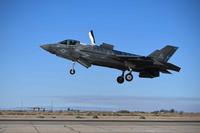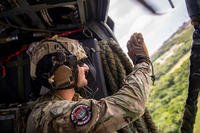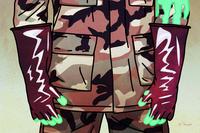Russia’s weeklong offensive in northeastern Ukraine is setting alarm bells ringing in Kyiv as President Volodymyr Zelenskyy and his generals rush to shore up their defenses.
Zelenskyy has canceled foreign travel plans for the next few days and on Thursday met with his key commanders in Kharkiv, the border city that’s become the focus of Moscow’s attacks. Russian forces penetrated as far as 10 kilometers (6.2 miles) inside Ukraine before being halted by Kyiv’s first line of defense, Zelenskyy told reporters in a late night briefing.
“Our defense forces have stabilized the Russians in the areas where they are located,” he said.
President Vladimir Putin said Friday on a visit to China that Russia has no plans to seize Kharkiv and is working on establishing a buffer zone to prevent cross-border shelling by Ukraine.
While the Kremlin appears to lack the necessary forces to actually capture Ukraine’s second largest city, the attacks are turning up the pressure on the country’s stretched defensive lines as they struggle with shortages of manpower, air defenses and artillery.
“The Russians don’t have the numbers necessary to do a strategic breakthrough” and there are no indications they’re generating such forces, General Christopher Cavoli, NATO’s supreme allied commander for Europe, told reporters Thursday after a two-day meeting of the alliance’s defense chiefs in Brussels.
“They don’t have the skill and the capability to operate at the scale necessary to exploit any breakthrough to strategic advantage,” he said. “I’m in very close contact with our Ukrainian colleagues and I’m confident that they will hold the line.”
Russia now has more than half a million troops attacking Ukraine, giving the Russians “significant” numerical superiority, according to Jack Watling, a senior research fellow for land warfare at the Royal United Services Institute, a UK think tank.
Watling said the Russian generals may be trying to force the Ukrainians to spread their forces along the 1,000-kilometer (600-mile) front line in order to create an area of weakness they can exploit. The push toward Kharkiv in Ukraine’s northeast could be followed by another attack close to the southern city of Zaporizhzhia, he said. That would draw Ukrainian reserves away from the eastern region of Donbas where Russia could then intensify its main offensive.
Others have suggested Russia could attempt an offensive further north in the Sumy region.
“There is pressure along the entire front line,” said Ruslan Pukhov, head of the Moscow-based think tank the Center for Analysis of Strategies and Technologies. “If the attack on Kharkiv can weaken Ukrainian positions in the south and east, then a breakthrough could come there.”
Putin’s trip to China this week aims to cement his relations with Xi Jinping and secure help for Russia’s war effort as the Kremlin seeks a breakthrough before the arrival of long-delayed U.S. military aid to Ukraine.
U.S. Secretary of State Antony Blinken, who visited Kyiv this week, said his country is rushing arms supplies into Ukraine to shore up forces battling the most serious incursion since the early days of the war more than two years ago.
Russia has been taking advantage of Ukraine’s shortage of air defenses to pound Kharkiv since last month, preparing the way for its infantry to advance. Last week its troops surged in northeastern Ukraine, seizing control of some villages and entering the town of Vovchansk, 5 kilometers from the border.
With Ukrainian Commander-in-Chief Oleksandr Syrskyi personally directing operations in the Kharkiv region, “decisive actions” by Kyiv’s units forced Russian troops to significantly reduce their activity, Ukraine’s General Staff said Thursday.
Ukrainian forces appear to have stabilized the front line in the region for now and the pace of Russian operations has slowed in recent days, according to people with knowledge of allied intelligence, who asked not to be identified discussing confidential reports.
Ukraine is at its most vulnerable right now, according to Dara Massicot, a senior fellow at the Carnegie Endowment for International Peace, with Russia likely to accelerate its attacks in the east and the full weight of Western lethal aid still to reach the front. All the same, she said, the Russians may not have the agility to take advantage.
“There are meaningful limits to Russian military power,” she said. “They still waste manpower in pursuit of their goals and Ukrainian forces are effective on the defense when they are supplied with men and materiel.”
The U.S. in April approved $61 billion in aid for Ukraine after six months of legislative obstruction by Republicans and is sending ammunition, armored vehicles, missiles and air defenses. But Kyiv remains frustrated by a U.S. ban on using U.S. weaponry to attack Russian territory and a delegation of Ukrainian lawmakers are lobbying to remove it on a trip to Washington this week.
Zelenskyy appealed to allies to allow Kyiv to use the western weapons to strike inside Russia.
While some Ukrainian parliamentarians say the U.S. policy prevented it from taking pre-emptive action to stop the Russian attack in the northeast, there’s been a wave of criticism by military bloggers in Ukraine of a lack of defenses in the border zone.
Putin on Wednesday told a meeting of military district commanders that Russian forces have pushed back all Ukrainian counter-attacks and in recent months “every day, on all fronts, they are constantly improving their position.”
Russia’s army delivered its first significant victory in months in February when it seized the strategic eastern city of Avdiivka.
A senior European diplomat said allies are concerned about the Russian progress but still hopeful that with the promised aid from the U.S. and other allies, Ukrainian forces will stabilize the front and eventually push Russian forces back.
Ukraine faces a long, drawn-out war of attrition because advances in technology mean that both sides can monitor each other as far as 15 kilometers behind the line of contact, according to Mykola Bielieskov, a prominent Ukrainian military analyst. That gives defensive forces a significant advantage over attackers.
Ukraine should pursue “active defense” to gradually exhaust Russia’s army, trading space for time and then restoring the front line through counterattacks with reserves brought from the depths, he said.
“The next year and a half will be a critically important period,” he wrote in a paper Thursday.
Russian troops have been making tactical advances in the northeastern Kharkiv region since May 10 and now seem to be focused on establishing a “buffer zone” by pushing deep into Kharkiv Oblast, the Washington-based Institute for the Study of War said Thursday in its daily bulletin. Russian border areas including the city of Belgorod have come under repeated Ukrainian shelling.
The Russian strategy is to “inflict a thousand cuts” to wear down the Ukrainian armed forces and create the conditions for achieving more significant gains, said Pukhov, the Moscow-based defense expert. The most realistic goal is to try and seize the entire Donbas, the eastern region whose years-long conflict stoked by Moscow provided the justification for Putin’s invasion of Ukraine, he added.
-------
(With assistance from Alberto Nardelli, Aliaksandr Kudrytski, Daryna Krasnolutska and Courtney McBride.)
___
©2024 Bloomberg L.P. Visit bloomberg.com. Distributed by Tribune Content Agency, LLC.












